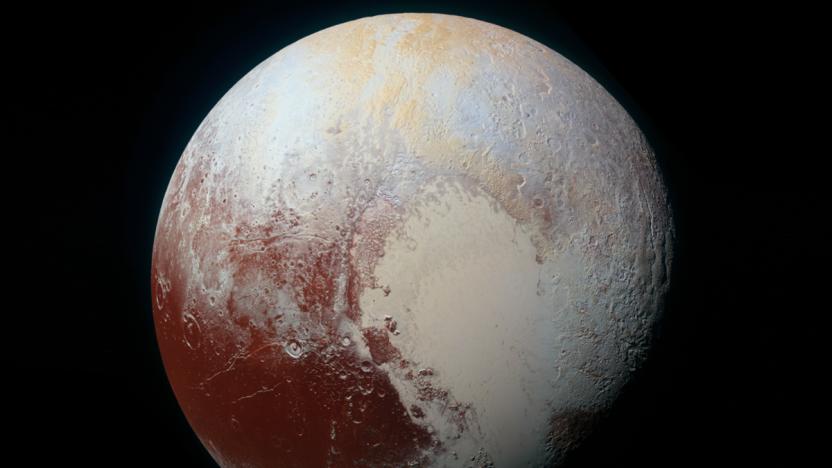ocean
Latest

Amazon is now managing its own ocean freight
Amazon has been working for a while now to build out its shipping and distribution network. Now the online retailer has started coordinating its own shipments from Chinese merchants to its warehouses in the US via ocean freighters. The Wall Street Journal reports that the company doesn't own any ships, but it's working as a freight forwarder and logistics provider. These are the companies that reserve space on freighters and handle trucking shipments from port to a warehouse. WSJ says that Amazon has coordinated shipment of 150 containers from China since October.

NASA uses space laser to study polar ocean plants
Usually when you think NASA you conjure up images of Mars and space stations. But the agency also conducts important climate research. One of those projects is the Cloud-Aerosol LIdar with Orthogonal Polarization (CALIOP) aboard the Cloud-Aerosol Lidar and Infrared Pathfinder Satellite Observation (CALIPSO) satellite that measures plankton levels through clouds.

SpaceX to launch ocean-monitoring NASA satellite in 2021
Elon Musk's SpaceX has been awarded a new contract to launch a NASA satellite in 2021. The Surface Water and Ocean Topography (SWOT) mission will begin at the Vandenberg Air Force Base in California, using a Falcon 9 rocket to take the research hardware into orbit. From there, NASA will conduct "the first-ever global survey of Earth's surface water," taking detailed recordings that should explain how our oceans change over time. The total cost of the launch is said to be $112 million, however the money won't be going to SpaceX alone. As the Verge reports, some is being put aside for other organisations providing "additional support."

Simulation of hidden ocean tides could lead to better sonar
There's a lot of tidal movement under the ocean's surface, but we haven't had a great understanding of it so far. Internal tides, created around continental shelf breaks, are far more difficult to predict than the ocean waves you can see. However, MIT researchers just made a breakthrough: they've accurately simulated those hidden tides for the first time. They melded a hydrodynamic model with data from a coastal sound wave study to replicate an ocean environment (in this case, a shelf break near the US' eastern coast) with a previously unseen level of complexity, complete with background elements like currents and eddies. The technique should be useful for predicting climates and fishing populations, but it could lead to a surprising amount of technological progress, too.

Pluto may have a 60 mile deep liquid water ocean
We used to think of Pluto as a remote frigid rock, but since the New Horizons visit, it's vying for the title of the solar system's most interesting (ex-) planet. An earlier study showed that its core is warm enough to support a liquid water ocean, and now we've learned that it might be huge -- at least 100 km (62 miles) deep. The evidence, according to the team from Brown University, comes from a likely impact with massive asteroid.

ICYMI: Sea power could take wind power's bragging rights
try{document.getElementById("aol-cms-player-1").style.display="none";}catch(e){}Today on In Case You Missed It: Nova Innovation is installing the world's first tidal power generators along the coast of Scotland, which are able to produce 100 kilowatts of power each. The UK Carbon Trust estimates the tidal energy market will be worth $165 Billion by 2050. The P-Laser that strips rust in an instant is here, and if you're as into amazing dogs as we are, you must see the nicknozzy YouTube channel. As always, please share any interesting tech or science videos you find by using the #ICYMI hashtag on Twitter for @mskerryd.

Researchers are building a robotic Lionfish exterminator
We joke around a lot about bringing about a horrific robot apocalypse, but let's get real: sometimes, building a killer robot is just the right thing to do. Well, at least when those robots are being used to cull invasive species. Researchers at Robots In Service of the Environment (RISE) are developing a robot to fight an invasive population of Lionfish that's threatening ecosystems off the coast of Florida as well as in the Caribbean and Bermuda.

328 foot-long floating barrier will collect ocean trash
There are numerous efforts underway to clean the world's oceans, but The Ocean Cleanup is testing what may be both the simplest and the most ambitious. It just launched a 328 foot-long prototype floating barrier that will collect trash floating in the North Sea. If it can survive the rough conditions of those waters, the plan is to deploy a 62 mile-long (!) barrier in the Pacific Ocean and reduce the size of the notorious Great Pacific Garbage Patch -- the hope is to halve the size of the trash field in 10 years.

ICYMI: Saving the ocean and ghosting on love interests
try{document.getElementById("aol-cms-player-1").style.display="none";}catch(e){}Today on In Case You Missed It: The Burner chatbot would let a machine ghost on acquaintances you'd rather not text with anymore. So that's point one for the endtimes, zero for humanity. But this Dutch inventor should more than switch that around with a small prototype of the ocean fence that is designed to collect ocean trash passively, allowing currents to push plastic and other stuff that doesn't belong in the water into a collection fence. If it all works out, a huge, 60-mile long version of his invention will grace the Pacific Ocean within a few years and hopefully be a solution to solving the Great Pacific garbage patch. If you're into Nerf guns, you must watch this video. As always, please share any interesting tech or science videos you find by using the #ICYMI hashtag on Twitter for @mskerryd.

Pluto might still have an ocean underneath its icy shell
Thanks to New Horizons, we now know just how complex Pluto's surface is, with its mountain ranges, deep cracks, volcanoes, canyons and heart-shaped plain. Scientists think those tectonic features are the result of a subsurface ocean slowly freezing over. According to a study led by Brown University graduate student Noah Hammond, though, tha ocean might still exist in liquid form even today. The team took into account all the data the probe gathered, such as Pluto's diameter and density to simulate a large body of water transforming into ice. Turns out the dwarf planet would have shrunk if the water its crust is hiding froze long ago. Its surface would have looked much different.

Adidas will release shoes made from ocean plastic this year
Adidas is committing to integrating recycled ocean waste into a general-release shoe this year. The sportswear company showed off a shoe with a 3D-printed midsole made from up-cycled ocean plastic late last year, as part of a collaboration with Parley, an anti-ocean-pollution organization. That was a one-off concept shoe, but off the back of that the company is now showing off a product titled Adidas x Parley. The new limited-edition shoe's upper is made from Parley Ocean Plastic and illegal deep-sea gillnets retrieved by the non-profit Sea Shepherd during a mission to protect sea life in the Southern Ocean. Announced to coincide with World Oceans Day, only fifty pairs will be made available, and they'll be given away through an Instagram contest.

ICYMI: Underwater robot snake, Earth's ocean saving and more
#fivemin-widget-blogsmith-image-54715{display:none;} .cke_show_borders #fivemin-widget-blogsmith-image-54715, #postcontentcontainer #fivemin-widget-blogsmith-image-54715{width:570px;display:block;} try{document.getElementById("fivemin-widget-blogsmith-image-54715").style.display="none";}catch(e){}Today on In Case You Missed It: Princeton researchers discovered ocean currents can move most anything around the globe within 10 years; which could help replenish dying ecosystems... and also spread around pollution. Norwegian engineers came up with a mechanical snake for underwater sea inspection and simple repair jobs near oil drills. And Harvard wants to encourage kid programming with a new robot that can be used by kindergartners to high schoolers. Once that's conquered, the answer is clearly to make the MIT open-source duckcar. As always, please share any great tech or science videos you find by using the #ICYMI hashtag on Twitter for @mskerryd.

ICYMI: Teleport your hologram, changing ocean pH and more
#fivemin-widget-blogsmith-image-681979{display:none;} .cke_show_borders #fivemin-widget-blogsmith-image-681979, #postcontentcontainer #fivemin-widget-blogsmith-image-681979{width:570px;display:block;} try{document.getElementById("fivemin-widget-blogsmith-image-681979").style.display="none";}catch(e){}Today on In Case You Missed It: Microsoft Research developed a new 3D camera capturing system that creates a live-time 3D hologram of a person that can be sent to interact with other people, as long as they have a matching virtual reality set-up. If that's confusing, the video straightens it right up.

Coral reefs will continue dying unless carbon output drops
Growing an endangered species of coral in a lab is one thing, but rebuilding a reef damaged by ocean acidification is a complete other. On paper, though, it's possible. A group of researchers attempted to counter the effects of rising carbon dioxide levels around Australia's Great Barrier Reef by pumping sodium hydroxide into lagoons that were isolated from the ocean during low tide, according to The Verge.

6 gadgets that clean the world's oceans
By Cat DiStasio In grade school, most children learn about the fragility of our ocean ecosystems. Despite this, the world's vast waters have become a de facto dumping ground for toxic chemicals, agricultural runoff and plastic trash. With ocean pollution at an all-time high, the question of how to turn it around weighs heavily on the minds of many environmentalists and engineers. So far they've come up with everything from oil-cleaning magic wands to massive floating cleanup arrays, but it's a race to see which method will most effectively reverse the damage humans have wrought. Which of these amazing gadgets do you think has the best shot at cleaning up our oceans?

ICYMI: Underground AI delivery, sea life discovery and more
#fivemin-widget-blogsmith-image-255157{display:none;} .cke_show_borders #fivemin-widget-blogsmith-image-255157, #postcontentcontainer #fivemin-widget-blogsmith-image-255157{width:570px;display:block;} try{document.getElementById("fivemin-widget-blogsmith-image-255157").style.display="none";}catch(e){}Today on In Case You Missed It: The Xenoturbella deep sea creature doesn't have a brain, eyes or functional gut, but its genetics prove it is one of the oldest forms of ocean life. Also, it looks like a discarded purple sock.

Watch SpaceX attempt a sea-based landing at 1:42PM ET
Flush with success from its first ground landing, SpaceX is about to make history again... well, maybe. The private space firm is scheduled to launch the ocean-monitoring Jason-3 satellite today (January 17th) at 1:42PM ET, and it hopes to once again attempt landing a Falcon 9 rocket on its drone barge. If everything goes ahead as planned, it'll be the first successful sea landing ever -- and SpaceX can put those unpleasant crashes behind it. You can watch the company's official stream below, while NASA TV has live coverage running before and during liftoff. Update: Unfortunately, the landing wasn't successful. [Image credit: SpaceX Photos, Flickr]

Amazon is getting into the oceanic freight shipping game
Virtually every product produced in Asia comes to the US by boat and, as such, oceanic shipping has become a $350 billion industry. Now, Amazon wants a piece of that action. The online mega-retailer's China division has been awarded clearance by the Federal Maritime Commission to conduct ocean freight services as a licensed Ocean Transportation Intermediary. That means it can legally ship goods for other companies. The new service, dubbed Fulfillment by Amazon (FBA), won't do much directly for individual consumers. However, it will allow Amazon's Chinese partners to more easily and cost-effectively get their products across the Pacific and into said customers waiting hands.

Automatic garbage bin promises to clean the oceans
Take a close look at the water in your local marina and you'll probably shudder at the amount of waste floating around. You'd practically need a dedicated clean-up crew to make it safe, wouldn't you? However, a pair of Australian surfers think they have a better way. Their crowdfunded Seabin promises to clean up marinas (and by extension, the ocean) through the one-two combo of a natural fiber garbage bin and an automated, above-the-water pump. It's almost too simple a concept, but it seems to work -- it sucks in all kinds of filth (including oil) and spits out clean water. You'd ideally leave a bunch of Seabins running at the dock all day, keeping the water relatively pristine.

Xprize offers $7 million for exploring the ocean floor
After years of focusing on moonshots and other lofty goals, the Xprize Foundation now hopes to inspire innovation in the opposite direction... in a very literal sense. Its new Shell Ocean Discovery Xprize is offering a total of $7 million in awards to teams that can deliver robotic exploration of sea floors as deep as 4,000m (13,123ft). The $4 million grand prize and a $1 million runner-up prize will go to the groups that deliver the sharpest maps on top of meeting baseline requirements for autonomy, depth and speed. The top 10 teams will split a $1 million milestone prize, while the National Oceanic and Atmospheric Administration is chipping in another $1 million for teams that spot objects through biological and chemical clues.











